1976 Austrian Grand Prix race report
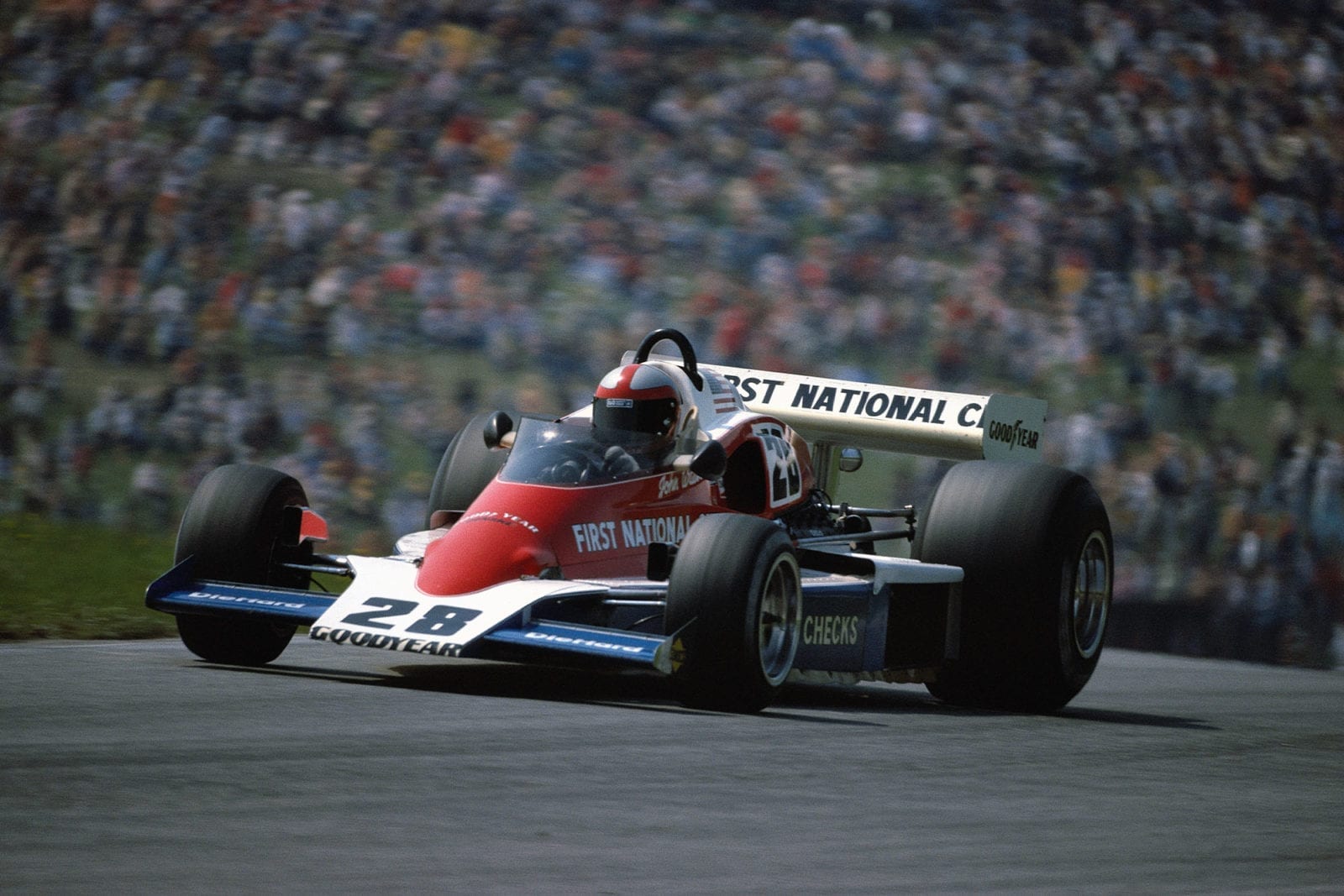
Watson took his debut win for Penske at Austria '76
Motorsport Images
The sun came out
Osterreichring, Knittelfeld, August 15th
Those who travelled from England to Austria for the Grand Prix on the Osterreichring discovered where all the rain had gone. There is no shortage of water in central Austria and violent thunderstorms rang through the mountains as the teams assembled in the paddock on the day before official practice. Some had already been indulging in some pre-race testing and Hunt (McLaren) and Watson (Penske) had been putting in some very competitive times, while Hunt also gave the brand-new M26 McLaren an airing. True to his word Enzo Ferrari did not send any cars to the Austrian GP, his withdrawal for the remainder of the season due to general dissatisfaction with the Formula One “circus” causing the Austrian organisers much anguish. With Niki Lauda still in hospital following his Nurburgring accident, the interest for Austrian spectators had dropped off badly. With a complete absence of any Ferrari cars there was little incentive for the usual thousands of Italians to pour across the Dolomites, and with Regazzoni being prevented from taking part there was little incentive for Swiss followers to journey from the Alps. Certain irresponsible branches of the Italian media, notably Television, were putting out suggestions that without Ferrari the Austrian GP would be cancelled. This was so far from the truth that it was absurd, but the gloomy weather covering central Austria did little to arouse much enthusiasm. One member of the organising club summed up the situation when I met him and said, “Hello, how are you ?” His pertinent reply was, “Personally I am very well, but as an organiser I am far from well.” One did not need to be a clairvoyant to see that the Austrian organisers were going to be lucky to attract 50% of their normal crowd, yet the Formula One Constructors’ Association were still demanding their full payment, even though it was one of their own members who was the prime cause of fading interest by the spectators. As the Raiffeisen Bank of Austria were sponsoring the event one presumes they were going to cover any losses; it was certain that Mr. Ecclestone and his cohorts were not going to accept less money, even though they were not honouring their contract due to the defection of one of the members of the Formula One Constructors’ Association.
Those members who were honouring the contract had worked the usual miracles since the last Grand Prix, or rather their mechanics and skilled workers had worked miracles, and in spite of six cars being badly damaged at the Nurburgring everyone was back with a full complement of pristine cars, even if some were having finishing touches put to them in the paddock on Friday morning when practice began. There was quite a lot of interesting speculation before proceedings began, such as who was going to challenge Hunt and the McLaren? Who was going to be alongside him on the front row of the grid, for somebody had to be, and without Lauda and the Ferrari the position was there for the taking? There was a feeling that the Alfa Romeo flat-12 engines might come into their own on this high-speed circuit, with no slow corners, and the thought of the Tyrrell six-wheelers with their four little pudgy front wheels working overtime on the down-hill under steer-provoking bends was intriguing. Among the back-markers the RAM Racing team had talked itself out of its legal predicament and was back in business with Loris Kessel, the originator of the sponsorship, while the Ensign team were wondering how their relatively unknown Austrian driver, Hans Binder, was going to cope with 450 b.h.p. The flat-out bend at the top of the hill after the pits, where Mark Donohue crashed last year, had been eased on the inside to make it even more flat-out, if that is possible, this alteration giving more run-off area on the outside. A vast new grandstand had been built on the outside of the down-hill Bosch Kurve, and the trees had been cut back on the last corner to give a better view of the cars coming into the pit straight. A memorial to Jochen Rindt had been put up alongside the entrance toad to the circuit.
Qualifying
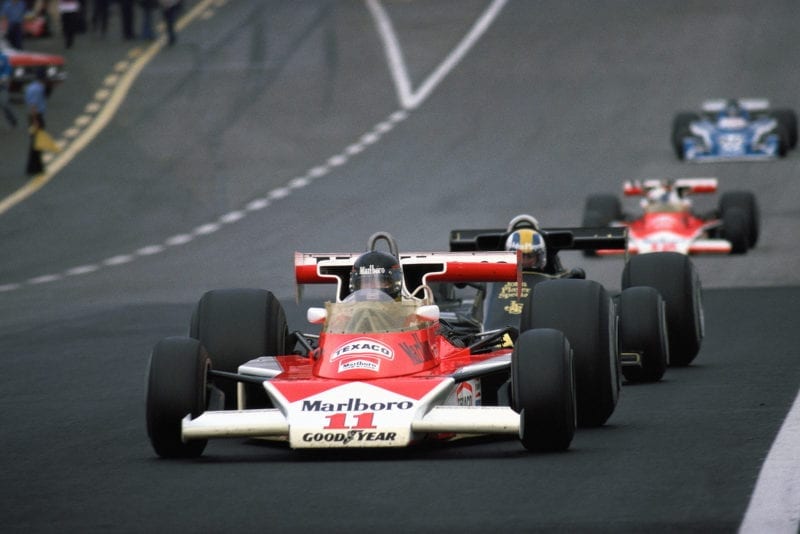
James Hunt took a sixth pole of the season
Motorsport Images
While practice got under way Lotus mechanics were finishing off Andretti’s car, 77/R3, so the USAC driver was using 77/R1, and Tyrrell mechanics were putting the finishing touches to the brand-new six-wheeler P34/4, Scheckter and Depailler using their regular mounts. Although conditions were dry they were far from being settled and the grey skies were reflected in a strange grey atmosphere in the pits as everyone accepted that the Scuderia Ferrari really were not there, and there didn’t Seem to be anyone to beat. Those who had already been doing some pre-race testing were soon into the swing of things, though the overall pace was not as fast as it should have been. There was a distinct air of lethargy about the place. In spite of this things still managed to go wrong, for the engine in Nilsson’s Lotus broke, Brambilla had a mild excursion off the road, and John Surtees felt that the air was not going the right way into the ducts on the new fronts on his cars and added some guide vanes. To appease some German rumblings behind Jochen Mass that McLaren’s were giving him a duff car, he was allowed out in Hunt’s spare car, but it didn’t make much difference! Not surprisingly Hunt recorded the fastest lap of the morning at 1 min. 35.02 sec., with John Watson next with 1 min. 35.84 sec., no-one else being within sight of them. The Alfa Romeo were not coming up to expectations, the Tyrrells had not got into the six-wheeled groove, and the Marches had not sorted themselves out, though Peterson was third fastest overall. While everyone ruminated on the situation during the lunch break the rain started and that was the end of the day as far as fast laps were concerned.
The one-hour practice period in the afternoon saw a reluctance for anyone to do anything, even though it was obviously never going to get dry and the low grey clouds looked as if they had come to the Zeltweg plain for good. Eventually Pace started the ball rolling, going out in the Brabham-Alfa Romeo BT45/4 with the carbon-fibre brakes, the car fitted with Goodyear wet weather tyres. The rain had more or less stopped but the track was still very wet and Pace was not creeping round reconnoitring, he was finding out just how fast he could go in the wet. As he went past the pits faster than some people go in the dry, one got the feeling that he was serious, and Brambilla soon joined him, followed by Depailler, the mini front tyres of the Tyrrell throwing up double the spray from their wet-weather treads. Kessel went out, having missed the morning practice while his car was being re-adjusted for him, and Andretti was out in the newer Lotus, while Nilsson took the spare Lotus while his own was having an engine change. A few more joined in, some only doing single exploratory laps, which is why they did not have a lap time recorded, but the whole day ended on a very low key and a wet one at that.
In accordance with the Ecclestone/Mosley rule-book, which at times seems to be more important than the FIA rule-book, the Saturday morning session of practice was not timed officially. It was on and off damp and dry and while Scheckter was having a drive in the new six-wheeler it broke its engine and Stuck also had engine trouble in his March. Once again the rain poured down during the lunch interval and clearly no-one was going to improve on the time they had done on the previous morning, however poor it had been. It was Harald Ertl who splashed off first to learn about driving in the rain, and he was soon followed by Peterson in the brand-new March and his time of 1 min. 54.50 sec. was to prove to be the best. Eventually the rain stopped and for a fleeting moment the sun shone, but it was all too late. With fifteen minutes to go the track was dry enough for some drivers to try “slick” tyres, but to no avail, time was against any last-minute heroics and the Formula One Constructors insist on the final practice session being from 1 p.m. to 2 p.m., and thus it was, the grid being assembled on the Friday morning times.
It was a very interesting grid, with Hunt (McLaren) and Watson (Penske) on the front row, the two Swedes, Peterson (March) and Nilsson (Lotus) in the second row, then Pryce (Shadow) and Laffite (Ligier). Behind these three rows were a whole gaggle of drivers who were not going to be content with their positions for long, these including Scheckter and Depailler (Tyrrells), Andretti (Lotus), Stuck (March), Brambilla (March), Mass (McLaren), and Pace (Brabham). The rest were more or less where they would normally be, the Austrian Hans Binder being well satisfied at having six cars behind him on his first Formula One attempt. In fact, the front half of the grid offered an interesting handicap event.
Race
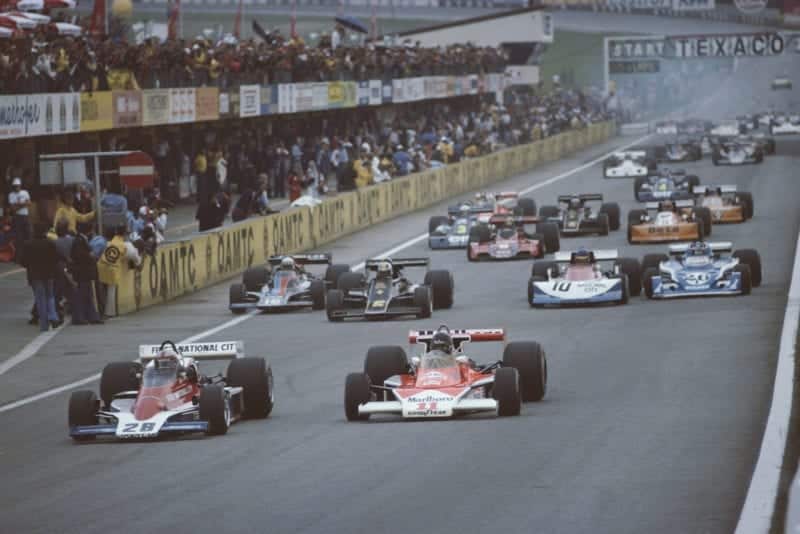
The race gets underway
Motorsport Images
On Sunday morning the skies were blue and the sun was shining but it was too late to encourage a large crowd, but even so the 60-70,000 was big by British standards even if it was only half of what had been budgeted for a month ago. From 10.40 to 11.00 a.m, there was a final test session and with a dry track and bright sunshine the whole Austrian GP suddenly came alive. The animation, excitement, vigour and enthusiasm in that twenty minutes was more than in the previous two days in total. A whole list of drivers and teams became aware that there was a race to be won. There was no Lauda and Ferrari on the front row, only Hunt and the McLaren. He was beatable surely, and alongside him was Watson with the Penske and everyone knew that that did not represent serious opposition, though the quiet bearded Ulsterman thought differently. It was his big chance and he was not going to throw it away, nor were Roger Penske and his men, and the car gleamed and scintillated as never before, with everything checked and re-checked and set to perfection. Previously the best had been good enough, now it was only just good enough, it all had to be better than the best. Drivers like Peterson, Andretti, Nilsson, Pace, Stuck, Scheckter, Depailler, Laffite and Brambilla were all getting really “charged-up” in the warm sunshine and this was going to be “one helluva race” or they would want to know the reason why. By mid-day there were some grey clouds appearing behind the mountainous back-drop to the Zeltweg plain, and valuable sunny weather was being wasted on a race for Alfa-Spud saloons, circus acts, comedy acts, flying displays and other irrelevancies for the Austrian Grand Prix was not due to start until 2 p.m. At 1 p.m. the Grand Prix cars and drivers slunk out of the paddock in a typically furtive fashion completely devoid of any pride or showmanship and the air had become ominously cool. By 1.30 p.m. the the first rain spots began to fall and all those involved in making decisions didn’t make any. By 2 p.m. there was still a spattering of rain but not enough to really dampen the track and it was announced that the race would start in ten minutes time if the rain spots did not develop. The race did not start at the end of the ten minutes, even though everyone was in position on the dummy-grid. The start line was a valley of indecision as “specialists” from this faction and that faction nattered away, and various people went round the circuit in one of the official Porsches to see how wet or dry it was. All the cars were on dry-weather tyres and the classic announcement was made that the track was “too wet for dry tyres and not wet enough for wet tyres”. A facetious voice was heard to mutter, “why don’t they run on the rims and get on with it”. Someone else looked to the west and murmured “at Le Mans they start the 24-hour race at 4 p.m. on Saturday afternoon, rain or shine or storm or tempest. At least you know where you stand”.
The sad thing about all this was that the “charge” put into everyone during the morning sunshine was beginning to run down. At 2.25 p.m. a decision was made, the race was classified “Dry” which meant it could be stopped if heavy rain developed, visible spray from the tyres determining the state of wetness. The 5-minute signal was given, everyone got ready and at 30 seconds the whole field moved forward and inhibitions were cast aside. The GPDA union official seemed to be interfering with the man with the Austrian flag, but none-the-less the start was given and 25 clutches were engaged in a glorious surge of power. Wheel-to-wheel, hub-to-hub, eyeball-to-eyeball, Hunt and Watson led the pack away on a superb start. The McLaren and the Penske were absolutely evenly matched as they went up the hill, neither driver flinching or giving an inch. Into the fast right-hander they went locked together, Watson determined not to give in and Hunt certain that the Ulsterman would. They were much too engrossed to worry about the screaming mob behind, and an unruly mob it was, led by Peterson.
That first corner was John Watson’s “moment of truth” and he grasped it with both hands and came out in front. Peterson went through and as the cars appeared in silhouette on the top straight the order was Penske, March, McLaren, Lotus. That first half lap was so enthralling that everyone forgot that rain spots were still falling, enough to dampen the track but not make it wet. The way they all came out of the last bend and hurtled down between the pits and the grandstands you would have thought the sun was shining. The order was Watson (Penske), Peterson (March), Hunt (McLaren), Nilsson (Lotus), Laffite (Ligier), Pryce (Shadow), Pace (Brabham), Scheckter (Tyrrell), Andretti (Lotus) all going like hell and proving that you can drive on a damp track on “slick” tyres. Twenty-four cars went by, for Reutemann had subsided on the hill after the start with a useless clutch. On the second lap Brambilla got all crossed up and wiped off his complete nose cowling, continuing at unabated pace as if he hadn’t noticed it had gone. Scheckter stormed through into sixth place and there was a lot of motor racing going on, not the usual GPDA-inspired procession. At the end of lap 3 Watson and Peterson were side-by-side as they crossed the line, it was just like racing used to be at Monza before Stewart and Fittipaldi ruined the circuit with chicanes. Watson refused to give in to the Swede that time, but on lap 5 Peterson did it and took the lead, but it was a precarious one and Scheckter was really under way, passing Nilsson on lap 6. and Hunt and Watson on lap 7.
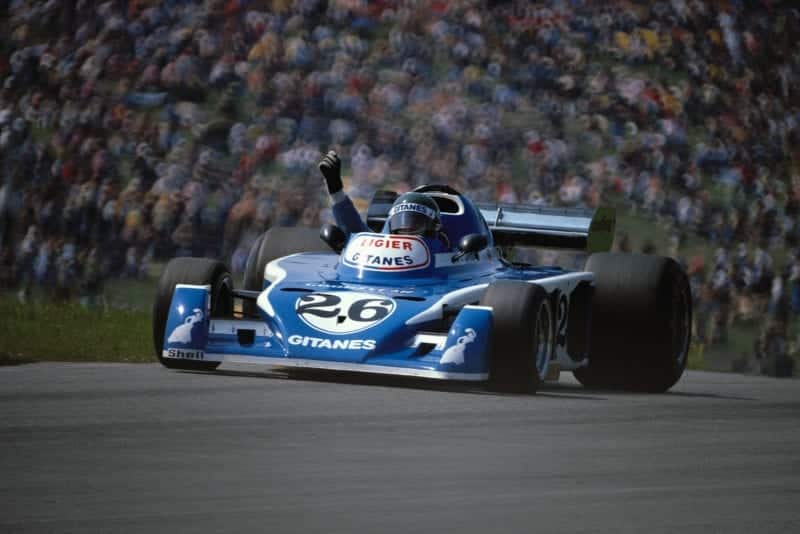
Jacques Laffite finished an impressive 2nd for Ligier
Motorsport Images
The rain spots had finally gone and a “gerfuffle” at the race control among the shop-stewards had subsided so all was well. Someone had seen spray off the tyres on a television screen and there had been panic measures to stop the race, but common sense or lurk had prevailed and the workers were left to get on with the very fine job they were doing. At 10 laps Scheckter got the six-wheeled Tyrrell into the lead and a wild, struggling mob consisting of the Tyrrell, the March, the Penske, Nilsson’s Lotus, Hunt’s McLaren and Laffite’s Ligier engulfed Jarier’s Shadow on all sides as they lapped him. They had already lapped Lombardi’s Brabham. The outcome of the next exciting lap was that Peterson was back in the lead, Scheckter was down to fourth place, Watson was second and Nilsson third, and on the next lap Watson and Peterson changed places. “Have they all gone mad?” was the query from one who thinks that Formula One is organised entertainment. “No” came the reply, “the GPDA is dead and they’ve all realised that Grand Prix racing is fun”. Everyone watching was certainly enjoying it, though the man from the First National City Bank Travellers Cheques was bemoaning his luck. For the first time none of the hierarchy or guests from the sponsors were at the race, and there was the Citibank-sponsored Penske in first place and the Citibank-sponsored March in second place, and Roger Penske and Max Mosley were eyeing each other.
Twelve laps had gone before it was possible to take stock of the situation. Watson (Penske) led from Peterson (March), hotly pursued by Nilsson (Lotus), Scheckter (Tyrrell), Hunt (McLaren), Laffite (Ligier) and Mass (McLaren). In the opening scramble Andretti (Lotus) had been left behind, but was now making up ground, with Stuck (March) and Pace (Brabham) having to watch him disappear into the distance. Depailler (Tyrrell) was next, having failed to get into the opening lap fighting, and Pryce (Shadow) had been elbowed down to his normal position in a race. Brambilla was still charging along without a nose cowling, and impossible handling if the aerodynamic specialists are to be believed, while Hunt was unable to challenge the leaders because something had moved the left-hand fin on the nose a degree or two and this had upset the handling of the car – if the aerodynamic specialists are to be believed! Bearded Harald Ertl was leading all the lesser lights, but Binder was doing a good job in the hired Ensign, sitting just behind the white Hesketh. Jones, Merzario and Fittipaldi followed, the rest having already been lapped. These comprised Pescarolo, Lunger, Rossi, Jarier, Lombardi and Kessel. The last-named had actually stopped just beyond the pits and was fixing a loose fuel union.
As Pryce drove his Shadow into the pits with the brakes not feeling nice on lap fifteen, the sun came out and conditions looked to be set fair. Watson was opening up a gap on Peterson for the March brakes had suffered in that opening bout, but the Swede was still a strong second. Going round the flat-out right-hand bend at the top of the hill after the pits, the suspension holding up the middle wheel on the right side of Scheckter’s Tyrrell broke and the car veered across the track into the barrier and bounced back across to the other side. As it went off it threw up a great wall of mud and water and Hunt and Laffite were covered in it as they narrowly missed the wayward Tyrrell. Scheckter stepped out somewhat shaken. This caused the McLaren and the Ligier to lose all contact with the leaders, but they still retained fourth and fifth places, respectively. Spurred on by the sight of Sweden’s number one driver ahead of him Gunnar Nilsson kept at it and on lap 19 he got by into second place, but by now Watson had pulled out a five-second gap and was beginning to run at his own pace, the Penske running perfectly and all systems were in 100 per cent order. Hunt and Laffite now had their sights on Peterson, while behind them Andretti had his sights on Mass. Still on the same lap as Watson were Pace, Stuck and Depailler, but the Tyrrell driver was not there for long as he also had a front suspension failure and subsided off the track less dramatically than Scheckter had, While lapping the slower cars Laffite took advantage of the traffic and got past Hunt and set out to catch Peterson. It was more a case of the March falling back into the clutches of the Ligier, which it did on lap 28, to be passed on lap 29, but Peterson refused to accept defeat and got back in front again on lap 30. The March, the Ligier and the McLaren were in a very tight bunch, and from being at the head of it on lap 30 Peterson found himself at the back of it on lap 31.
Almost unnoticed, except by those close at hand, Alan Jones went off the road and hit a safety net pole sideways, wrecking the monocoque of the Surtees and down among the lesser men Fittipaldi was overtaken by Lunger and was soon to he lapped for the second time by Watson. At 36 laps clouds obscured the sun but it was quite harmless and there was nothing to stop Watson’s dominating drive and he had more than twelve seconds lead over Nilsson. The young Swede was rather worried because the oil pressure of his Cosworth engine was down to 60 p.s.i. from its more normal 80-85 p.s.i. and it was still falling. Laffite was right behind him and was screwing the Matra V12 engine up harder and harder, ready to get past the Lotus. Starting the forty-third lap the Ligier was side-by-side with the Lotus, but Nilsson “sat-it-out” with the Frenchman and a chastened Laffite realised he would have to try another tactic to dislodge the Swede from second place. Two laps later he was ready for another attack, this time out on the back of the circuit, and this time it succeeded. With nine laps to go and the oil pressure down to 40 p.s.i. Nilsson settled for third place with his fingers crossed. Hunt was in fourth place, nursing his in-built excuse for not winning, and Andretti had displaced poor Peterson from fifth place. Brambilla had been persuaded to stop and have a new nose cowling fitted, but he now got tangled up with Fittipaldi and the two of them ended up off the road without injury but with bent motor cars.
With only five laps left to run the unfortunate Hans Binder found the Ensign dying on him with no connection between the accelerator pedal and the engine, as a split pin had fallen out and the clevis pin at the end of the cable had dropped out of its fork. He could not get back to the pits and had no way of effecting a repair. Others had fallen by the wayside, some noticed and some not; some heavily and some lightly. The carbon-fibre brakes on Pace’s Brabham-Alfa Romeo had boiled the fluid and the Brazilian had gone off the track at high speed, writing off the monocoque, but escaping injury. Stuck’s March had succumbed quietly with no fuel pressure and Jarier’s Shadow had gone out with a defective fuel pump. With one lap to go Lunger’s Surtees suddenly lost all its brake pressure and the American slid off the track and out of the race, but was considered a finisher.
Looking extremely confident and completely cool and relaxed John Watson chalked up his first Grand Prix win and the first for the Penske team, the car looking as immaculate at the finish as it had done at the start. Some winners who finish have a list of technical defaults that plagued them throughout their magnificent drive, with “understeer towards the end of the race” or “a slight handling problem about half way through” or “the tyres went off after 25 laps” or “fluctuating fuel pressure had me worried”. John Watson said after the race “Marvellous, everything worked perfectly.” He had worked perfectly as well.
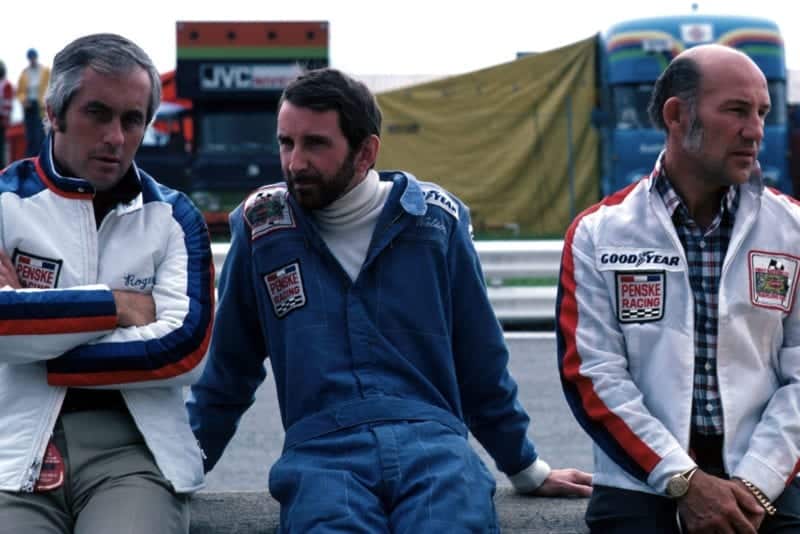
It was a first victory for both John Watson (centre) and Roger Penske (left)
Motorsport Images
Almost at the end of his slowing-down lap Nilsson had his engine go bang, and he thumbed a lift on the side of the McLaren of Jochen Mass, to arrive to take a joyous third place on the victors’ rostrum alongside Watson and Laffite. The Frenchman joined Watson in drinking the celebratory champagne rather than squirting over the photographers. Back in the paddock big Wilson Fittipaldi was looking for Brambilla, having heard what the nasty rough Italian had done to “little brother”, the Penske team were justifiably beaming with satisfaction, and with two cars in the first six the Team Lotus fans were still keeping their faith in Colin Chapman. Apart from the financial manipulators everyone was pretty happy and everyone had enjoyed the race, for it really had been a race, and not Formula One entertainment. Some of us were having to admit to the sacrilegious thought that you can have a motor race without Ferrari.—D.S.J.
